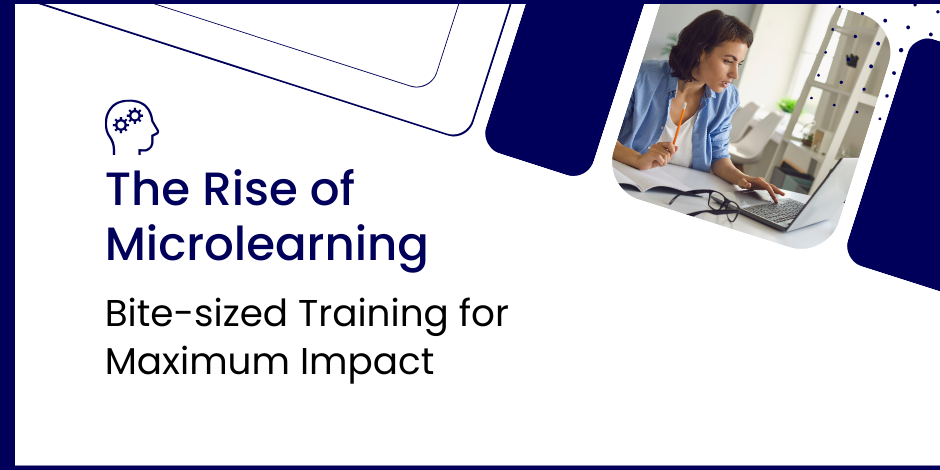The Rise of Microlearning: Bite-Sized Training for Maximum Impact

Stay Informed With Our Weekly Newsletter
Receive crucial updates on the ever-evolving landscape of technology and innovation.
Today’s fast-paced world challenges traditional approaches to learning and development. The rise of microlearning has revolutionised training by offering bite-sized modules that deliver maximum impact.
Understanding the concept of microlearning

Microlearning delivers small, focused units of information that are easy to digest and understand. Unlike traditional training methods, which often involve lengthy lectures or extensive training sessions, microlearning breaks down complex topics into concise, targeted modules.
Each module typically lasts no longer than 10 minutes, making it ideal for today’s busy learners.
Microlearning recognises that learners have limited attention spans and may struggle to retain large amounts of information in one go. By presenting information in short, easily digestible chunks, microlearning allows learners to absorb knowledge more effectively.
Defining microlearning in the modern context
In the modern context, microlearning goes beyond traditional e-learning modules. It embraces a multimedia approach, combining text, images, videos, and interactive elements to engage learners effectively.
Microlearning caters to various learning styles using different media formats and helps enhance knowledge retention.
Interactive lessons include short videos of native speakers conversing, accompanied by text and audio explanations, allowing you to grasp the nuances of the language at your own pace.
Furthermore, microlearning platforms often incorporate gamification elements to make the learning experience more enjoyable, such as earning points, and badges, or competing with other learners in quizzes and challenges. This gamified approach motivates learners and reinforces the knowledge gained through microlearning modules.
The evolution of microlearning
The rise of microlearning has its roots in cognitive psychology and the concept of chunking. Chunking refers to breaking information into smaller, manageable units.
This approach facilitates better comprehension and memory retention. Researchers have found that our working memory can only hold a certain amount of information at a time.
By presenting information in bite-sized chunks, microlearning optimises our working memory, allowing us to process and retain information more effectively.
Technological advancements have made microlearning even more accessible and widespread, empowering individuals to acquire knowledge at their own pace. Mobile devices like tablets and smartphones have made microlearning portable and convenient.
In addition, the rise of online communities and social media has facilitated the sharing of microlearning resources.
Learners can connect with experts and fellow learners, exchanging tips, insights, and additional resources related to the microlearning topics. This collaborative aspect of microlearning fosters community and encourages continuous learning.
The benefits of bite-sized training

When it comes to learning, less can sometimes be more. Research shows learners retain information better when delivered in small, concentrated doses.
By presenting information in bite-sized chunks, microlearning allows learners to focus on specific topics without overwhelming them. This targeted approach enhances knowledge retention and ensures learners can apply what they’ve learned in practical situations.
Enhancing knowledge retention with the rise of microlearning
Research has shown time and time again that the human brain is more likely to remember information when presented in short, focused bursts. This is known as the “spacing effect”.
Microlearning takes advantage of this effect by spacing out learning sessions and delivering information in mini modules and helps learners retain knowledge for extended periods.
Focusing on one aspect allows for consolidation of information and a much better chance of retention. Microlearning also allows for repetition, which is key to reinforcing learning.
By delivering information in small chunks, learners can quickly review and revisit the content whenever needed. This repetition helps to strengthen neural connections and solidify the knowledge in their long-term memory.
The rise of microlearning for busy professionals
Training and development is a challenge in today’s fast-paced work environment. With its short, easily accessible modules, microlearning offers a flexible solution accommodating professionals’ hectic schedules.
Whether during a commute, a lunch break, or even a few minutes before a meeting, professionals can engage in microlearning and make the most of their limited time. This on-the-go learning approach allows them to maximise productivity and stay up-to-date with industry trends and best practices.
The rise of microlearning is a game-changer whether you’re a busy professional looking to upskill or an organisation seeking an effective training solution. Its bite-sized format enhanced knowledge retention, and its flexibility makes it invaluable for continuous learning and development.
The science behind microlearning
The role of cognitive load theory in microlearning
Cognitive load theory suggests that learners have limited working memory. By presenting information in small chunks, microlearning reduces cognitive load, allowing learners to focus on absorbing and processing the material effectively.
This approach minimises the chances of information overload and promotes better understanding and retention.
How the rise of microlearning aligns with the forgetting curve
The forgetting curve describes how information is forgotten over time if not reinforced. Microlearning leverages the spacing effect, which involves revisiting information at intervals to reinforce memory and increase retention.
By delivering training content in short, spaced intervals, microlearning combats the forgetting curve and ensures learners retain knowledge for the long term.
Implementing microlearning in your organisation
Key considerations for developing microlearning content
When developing microlearning content, aligning it with the organisation’s overall learning objectives and target audience is crucial. Content should be concise, engaging, and relevant, focusing on specific learning outcomes.
Utilising a variety of multimedia formats helps cater to different learning preferences and promotes active engagement.
Overcoming potential challenges in microlearning implementation
While the rise of microlearning offers many advantages, it also presents challenges that organisations must address. One challenge is ensuring the availability of suitable technology and platforms for delivering microlearning content.
Compatibility and accessibility across different devices and operating systems are essential, as is ongoing support and feedback to learners to ensure effective implementation.
The future of microlearning

The future of microlearning looks promising, with emerging trends and the digital transformation of education.
Emerging trends in microlearning
Some emerging microlearning trends include personalised learning experiences, gamification, virtual reality, and augmented reality. These trends offer exciting possibilities for enhancing engagement and effectiveness, allowing learners to experience immersive and interactive training in a previously unimaginable way.
The rise of microlearning and the digital transformation of education
The digital transformation of education has accelerated the adoption of microlearning. With the increase in online learning platforms and learning management systems, learners can access vast amounts of microlearning resources.
This democratisation of knowledge allows individuals from all walks of life to acquire new skills and expertise conveniently and affordably.
Conclusion
The rise of microlearning has revolutionised training by offering bite-sized modules that deliver maximum impact. This learner-centric approach enhances knowledge retention and fits seamlessly into today’s fast-paced world.
By understanding the concept, benefits, and science behind microlearning and implementing it strategically, organisations can keep their workforce continuously upskilled and future-ready in the digital age.
Visit the Institute of Data to learn how our corporate training programs can supercharge your organisation’s knowledge acquisition. Become the future-ready and enhance your business today!


